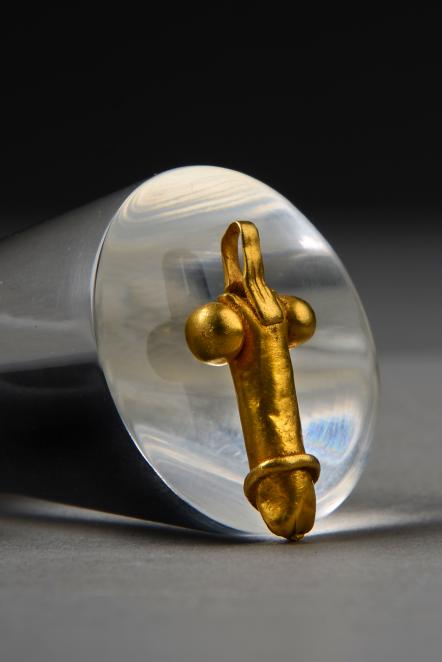Romano-British pendant
Accession Number KILLM : 2012.1
Description
A rare gold Romano-British pendant in the shape of a phallus. The pendant is 2cm long, straight, oval sectioned, hollow, formed of rolled or beaten sheets of gold soldered together lengthways, rounded at the terminal with a small aperture left open at either end. A separate transverse loop formed from triple ribbed sheet is soldered into position at the top, with separately applied solid globular testicles to either side. Separately applied wire with irregular transverse grooves on the underside (perhaps to act as keying for the solder) defines the edge of the foreskin. The pendant is in good condition but worn, with the ribs on the attachment loop completely worn away over most of the surface.
Read MoreRomano-British pendant
This gold Romano-British pendant, found in Hillington, Norfolk is a rare find. Its special significance lies in the symbolism of the object and what is tells us about life in the Roman Empire and people’s belief systems. Phallic amulets were commonly worn in Roman times both as a symbol of sexuality, and to promote fertility. Ancient Romans believed that sexual symbols like this gold phallus would shield them from harm and protect them from evil curses. Eroticism and sexuality were prevalent in every form of Roman art, from paintings, to sculpture, and even jewellery. In Roman beliefs, the deity Fascinus was considered the root of the divine phallus. The word ‘Fascinus’ can refer to phallus effigies, amulets, and spells, as well as the deity itself. Indeed, sexuality in ancient Roman society has sometimes been referred to as "phallocentric". Social attitudes to sexual behaviors in ancient Roman culture differ quite significantly to later Western societies. The strict binary of "homosexual" and "heterosexual" was not central to Roman thinking about sexuality, which is indicated by the fact that no words for these concepts exist in Latin. Men who enjoyed sex acts with either women or men were not automatically considered inferior. If it was not exacerbated by personal weaknesses and did not impact on other men, sex with male prostitutes or slaves was not regarded as inappropriate. Perceived effeminacy however was frowned upon, especially in political spheres, and such liberal thought did not usually extend to women, who were generally held to stricter moral codes.





